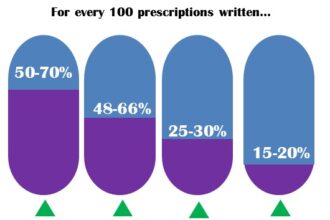Whenever the adequacy of the future primary care workforce is discussed, invariably someone links the declining numbers of medical students entering primary care to student debt. We see this in: questions to President Obama; testimony to Congress; New York Times articles and editorials; a piece in Newsweek on the primary care shortage; a briefing posted by the medical student section of the AMA; reports issued by foundations; formal policy statements from physician associations; or in recent blog posts by medical students on the topic. All this, despite the fact that empirical research has failed to establish any such relationship. To wit, no one has definitively established what so many assume.
Saying It Does Not Make It So
Many observe the widening salary differential between primary care physicians and most specialists, the declining number of medical students entering primary care today, and the continued increase in medical education debt, and make an unsubstantiated leap in logic to conclude that indebted students are less likely to consider a career in primary care. In truth, research has confirmed no such connection. A 2003 meta-analysis that explicitly assessed the quality of published research on debt and choosing to specialize in family medicine concluded that the relationship was unclear. A more recent attempt to prove this relationship fared no better.
This is not to say that reduced student debt is undesirable, or that it would have no effect. The rising level of medical school debt concerns us greatly as a barrier to medical school entry. Nonetheless, there is simply no clear and convincing body of proof that it has any bearing on whether or not medical students ultimately choose careers in primary care. Reducing or even eliminating medical school tuition, as suggested in a New York Times editorial,might make it more feasible to go to medical school, but there is no evidence that eliminating tuition or minimizing debt burden would transform incoming students’ specialty choice preferences.
The Truth Is Complicated
The choice of specialty, primary care or otherwise, is a complex decision that is based on multiple factors, including students’ interest in the specialty, exposure to the specialty (positive and negative), relationships with mentors and role models, interest in work-life balance, compensation goals, gender, race/ethnicity, and rural background, among others. While debt may play a minor role in the decision, evidence suggests it is largely trumped by these other considerations. So a constant beating upon the debt drum will only mislead all who are interested in increasing the production of primary care physicians in this country.
The recruitment of more students into medical school who are inclined to pursue primary care, including more from rural backgrounds and more married students and women, could result in more medical school graduates practicing primary care. Reducing the gap in physician pay scales would also likely induce more students to enter primary care, and it is undoubtedly a necessary part of any strategy to address the nation’s primary care shortage. Indeed, we believe that primary care should be reimbursed more rationally. But this does not mean that debt is driving potential physicians away from primary care practice.
Medical school students will continue to choose careers that appeal to them. Both the medical home model and other system redesign incentives included in the Affordable Care Act that focus on improving care coordination offer potential options for increasing satisfaction levels and interest in the field. The nation also needs to establish medical care models that will allow the next generation of primary care physicians to have the controllable schedules they need and so clearly desire. These opportunities for enhancing primary care are time-sensitive, though, and we fear that focusing so much attention on a single policy lever, such as medical school debt, will cause us to fail to take advantage of them. We have hopes that the Patient Protection and Affordable Care Act will improve primary care practice and pay, but much more still needs to be done.
—Mr. Dill is a Senior Data Analyst at the AAMC’s Center for Workforce Studies. His current work focuses on physician demand, access to care, workforce projections modeling, and physician workforce diversity. He received his Master of Public Affairs and Policy from Rockefeller College, and he is currently pursuing his Ph.D. in Sociology through the University at Albany, SUNY. He is a guest blogger for the AAMC-powered Wing of Zock, and can be reached at mdill@aamc.org. Clese Erikson and Henry Sondheimer also contributed to this post.








